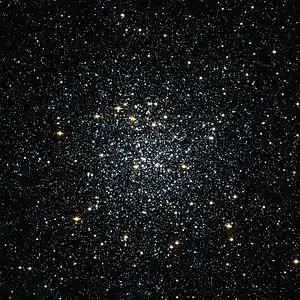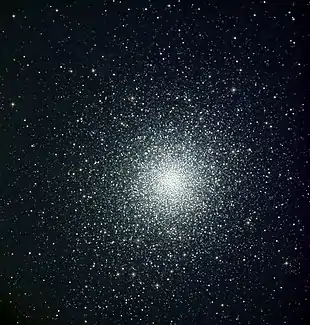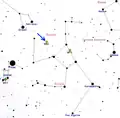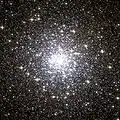| Messier 92 | |
|---|---|
 Center of M92 by HST; 1.44′ view | |
| Observation data (J2000 epoch) | |
| Class | IV[1] |
| Constellation | Hercules |
| Right ascension | 17h 17m 07.39s[2] |
| Declination | +43° 08′ 09.4″[2] |
| Distance | 26.7×103 ly (8.2 kpc)[3] |
| Apparent magnitude (V) | 6.4[4] |
| Apparent dimensions (V) | 14' arc minutes |
| Physical characteristics | |
| Mass | 2.0×105[5] M☉ |
| Metallicity | = –2.32[6] dex |
| Estimated age | ?[7] |
| Other designations | M92, NGC 6341, GCl 59[8] |
Messier 92 (also known as M92, M 92, or NGC 6341) is a globular cluster of stars in the northern constellation of Hercules.
Discovery
It was discovered by Johann Elert Bode on December 27, 1777, then published in the Berliner Astronomisches Jahrbuch during 1779.[9][10] It was inadvertently rediscovered by Charles Messier on March 18, 1781,[lower-alpha 1] and added as the 92nd entry in his catalogue.[11] William Herschel first resolved individual stars in 1783.
Visibility
It is one of the brighter of its sort in apparent magnitude in the northern hemisphere and in its absolute magnitude in the galaxy, but it is often overlooked by amateur astronomers due to angular proximity to bright cluster Messier 13, about 20% closer. Though when compared to M13, M92 is only slightly less bright, but about 1/3 less extended. It is visible to the naked eye under very good viewing conditions.[12] With a small telescope, M92 can be seen as a nebulous smudge even in a severely light-polluted sky, and can be further resolved in darker conditions.
Characteristics
It is also one of the galaxy's oldest clusters. It is around 16×103 ly (4.9 kpc) above/below the galactic plane and 33×103 ly (10 kpc) from the Galactic Center.[13] It is about 26,700 light-years away from the Solar System.The half-light radius, or radius containing the upper half of its light emission, is 1.09 arcminutes (′), while the tidal radius, the broadest standard measure, is 15.17′. It appears only slightly flattened: its minor axis is about 89% ± 3% of the major.[3]
Characteristic of other globulars, it has little of the elements other than hydrogen and helium; astronomers term this low metallicity. Specifically, relative to the Sun, its iron abundance is [Fe/H] = –2.32 dex,[13] which is 0.5% of 1.0, on this logarithmic scale, the solar abundance.[14] This puts the estimated age range for the cluster at 11 ± 1.5 billion years.[15]
Its true diameter is 109 ly, and may have a mass corresponding to 330,000 suns.[16]
The cluster is not yet in, nor guaranteed to undergo, core collapse and the core radius figures as about 2 arcseconds (″).[13] It is an Oosterhoff type II (OoII) globular cluster, which means it belongs to the group of metal-poor clusters with longer period RR Lyrae variable stars. The 1997 Catalogue of Variable Stars in Globular Clusters listed 28 candidate variable stars in the cluster, although only 20 have been confirmed. As of 2001, there are 17 known RR Lyrae variables in Messier 92.[17] 10 X-ray sources have been detected within the 1.02 arcminute half-mass radius of the cluster, of which half are candidate cataclysmic variable stars.[18][19]
M92 is approaching us at 112 km/sec. Its coordinates indicate that the Earth's North Celestial Pole periodically passes less than one degree of this cluster during the precession of Earth's axis. Thus, M92 was a "Polarissima Borealis", or "North Cluster", about 12,000 years ago (10,000 BC), and it will again in about 14,000 years (16,000 AD).[16]
The multiple stellar populations in this cluster, revealing that it hosts at least two stellar generations of stars named 1G and 2G, as well as two distinct groups of 2G stars (2GA and 2GB).[20] The helium abundances of 2GA and 2GB stars have higher mass fractions than that of the 1G stars by 0.01 and 0.04, respectively.
Gallery
 Messier 92 - wide field view from the Isaac Newton Group of Telescopes
Messier 92 - wide field view from the Isaac Newton Group of Telescopes Map showing how Messier 92 figures in the two-dimensional sky, in the east of Hercules. Maps set by convention against a southern horizon, such that east is left.
Map showing how Messier 92 figures in the two-dimensional sky, in the east of Hercules. Maps set by convention against a southern horizon, such that east is left..jpg.webp) Messier 92 by the Sloan Digital Sky Survey
Messier 92 by the Sloan Digital Sky Survey Messier 92 by HST; 3.5′ view
Messier 92 by HST; 3.5′ view.png.webp) Messier 92 captured by the James Webb Space Telescope’s NIRCam instrument
Messier 92 captured by the James Webb Space Telescope’s NIRCam instrument
See also
References and footnotes
- ↑ Shapley, Harlow; Sawyer, Helen B. (August 1927), "A Classification of Globular Clusters", Harvard College Observatory Bulletin, 849 (849): 11–14, Bibcode:1927BHarO.849...11S.
- 1 2 Goldsbury, Ryan; et al. (December 2010), "The ACS Survey of Galactic Globular Clusters. X. New Determinations of Centers for 65 Clusters [ Erratum: 2011AJ....142...66G ]", The Astronomical Journal, 140 (6): 1830–1837, arXiv:1008.2755, Bibcode:2010AJ....140.1830G, doi:10.1088/0004-6256/140/6/1830, S2CID 119183070
- 1 2 Chen, C. W.; Chen, W. P. (October 2010), "Morphological Distortion of Galactic Globular Clusters", The Astrophysical Journal, 721 (2): 1790–1819, Bibcode:2010ApJ...721.1790C, doi:10.1088/0004-637X/721/2/1790
- ↑ "Messier 92". SEDS Messier Catalog. Retrieved 30 April 2022.
- ↑ Marks, Michael; Kroupa, Pavel (August 2010), "Initial conditions for globular clusters and assembly of the old globular cluster population of the Milky Way", Monthly Notices of the Royal Astronomical Society, 406 (3): 2000–2012, arXiv:1004.2255, Bibcode:2010MNRAS.406.2000M, doi:10.1111/j.1365-2966.2010.16813.x, S2CID 118652005. Mass is from MPD on Table 1.
- ↑ Forbes, Duncan A.; Bridges, Terry (May 2010), "Accreted versus in situ Milky Way globular clusters", Monthly Notices of the Royal Astronomical Society, 404 (3): 1203–1214, arXiv:1001.4289, Bibcode:2010MNRAS.404.1203F, doi:10.1111/j.1365-2966.2010.16373.x, S2CID 51825384.
- ↑ Paust, Nathaniel E. Q.; Chaboyer, Brian; Sarajedini, Ata (June 2007), "BVI Photometry and the Luminosity Functions of the Globular Cluster M92", The Astronomical Journal, 133 (6): 2787–2798, arXiv:astro-ph/0703167, Bibcode:2007AJ....133.2787P, doi:10.1086/513511, S2CID 13160815
- ↑ "M 92". SIMBAD. Centre de données astronomiques de Strasbourg. Retrieved 2006-11-17.
- ↑ Bode (1779). "Zweyter Theil 20. Beobachtung des Kometen von 1779 und Entdeckung einiger neuen Nebelsterne [Second Part. 20. Observation of the comet of 1779 and discovery of some new nebulae]". Astronomisches Jahrbuch oder Ephemeriden für das Jahr 1782 [Astronomical Yearbook or Ephemerides for the Year 1782.] (in German). Berlin, (Germany): George Jacob Decker. p. 156. From p. 156: " […] ich am 27. Decemb. 1777 einen neuen, mir nicht bekannten Nebelfleck im Herkules, südwestlich unter dem Stern ⍳ an dessen Fusse entdeckt, der sich in einer mehrentheils runden Figur mit einem blassen Lichtschimmer zeigt." ( […] on the 27th December 1777, I discovered a new nebula, which was unknown to me, in Hercules, southwest under the star ⍳ [iota] at his feet, which appears as a mostly round shape with a pale glimmer.)
- ↑ Kanas, Nick (2007), Star maps: history, artistry, and cartography, Springer-Praxis books in popular astronomy, Springer, p. 180, ISBN 978-0387716688
- ↑ Garfinkle, Robert A. (1997), Star-Hopping: Your Visa to Viewing the Universe, Cambridge University Press, p. 131, ISBN 978-0521598897
- ↑ Frommert, Hartmut; Kronberg, Christine (September 2, 2007), "Messier 92", SEDS, The Munich Astro Archive, archived from the original on 2016-03-04, retrieved 2012-04-08
- 1 2 3 Drukier, G. A.; et al. (March 2007), "The Global Kinematics of the Globular Cluster M92", The Astronomical Journal, 133 (3): 1041–1057, arXiv:astro-ph/0611246, Bibcode:2007AJ....133.1041D, doi:10.1086/510721, S2CID 15452502
- ↑ Since 10−2.29 = 0.00513.
- ↑ Di Cecco, A.; Becucci, R.; Bono, G.; Monelli, M.; Stetson, P. B.; Degl'Innocenti, S.; Moroni, P. G. Prada; Nonino, M.; Weiss, A.; Buonanno, R.; Calamida, A. (2010-06-27). "On the absolute age of the Globular Cluster M92". Publications of the Astronomical Society of the Pacific. 122 (895): 991–999. arXiv:1006.5217. Bibcode:2010PASP..122..991D. doi:10.1086/656017.
- 1 2 "Messier Object 92". www.messier.seds.org. Retrieved 2022-05-28.
- ↑ Kopacki, G. (2003), "Variable stars in the globular cluster M 92", Astronomy and Astrophysics, 369 (3): 862–870, arXiv:astro-ph/0211042, Bibcode:2001A&A...369..862K, doi:10.1051/0004-6361:20010155, S2CID 116811988
- ↑ Lu, Ting-Ni; et al. (August 2011), "Chandra and HST Studies of the X-Ray Sources in Galactic Globular Cluster M92" (PDF), The Astrophysical Journal, 736 (2): 158, Bibcode:2011ApJ...736..158L, doi:10.1088/0004-637X/736/2/158, hdl:1721.1/95659, S2CID 54766335
- ↑ Ferraro, F. R.; Paltrinieri, B.; Fusi Pecci, F.; Rood, R. T.; Dorman, B. (1998-01-01). "Faint UV Objects in the Core of Ggcs: a New Subclass of Cvs?". Ultraviolet Astrophysics Beyond the IUE Final Archive. 413: 561. Bibcode:1998ESASP.413..561F.
- ↑ World, FTT. "Astronomers discover new insights into multiple stellar populations in Messier 92 using James Webb".
- ↑ On March 18
External links
- Messier 92 on WikiSky: DSS2, SDSS, GALEX, IRAS, Hydrogen α, X-Ray, Astrophoto, Sky Map, Articles and images
- Messier 92 @ SEDS Messier pages
- Messier 92, Galactic Globular Clusters Database page
- Merrifield, Michael; Crowther, Paul. "M92 – Globular Cluster". Deep Sky Videos. Brady Haran.
- NASA Astronomy Picture of the Day: Comet Garradd and M92 (4 February 2012)
